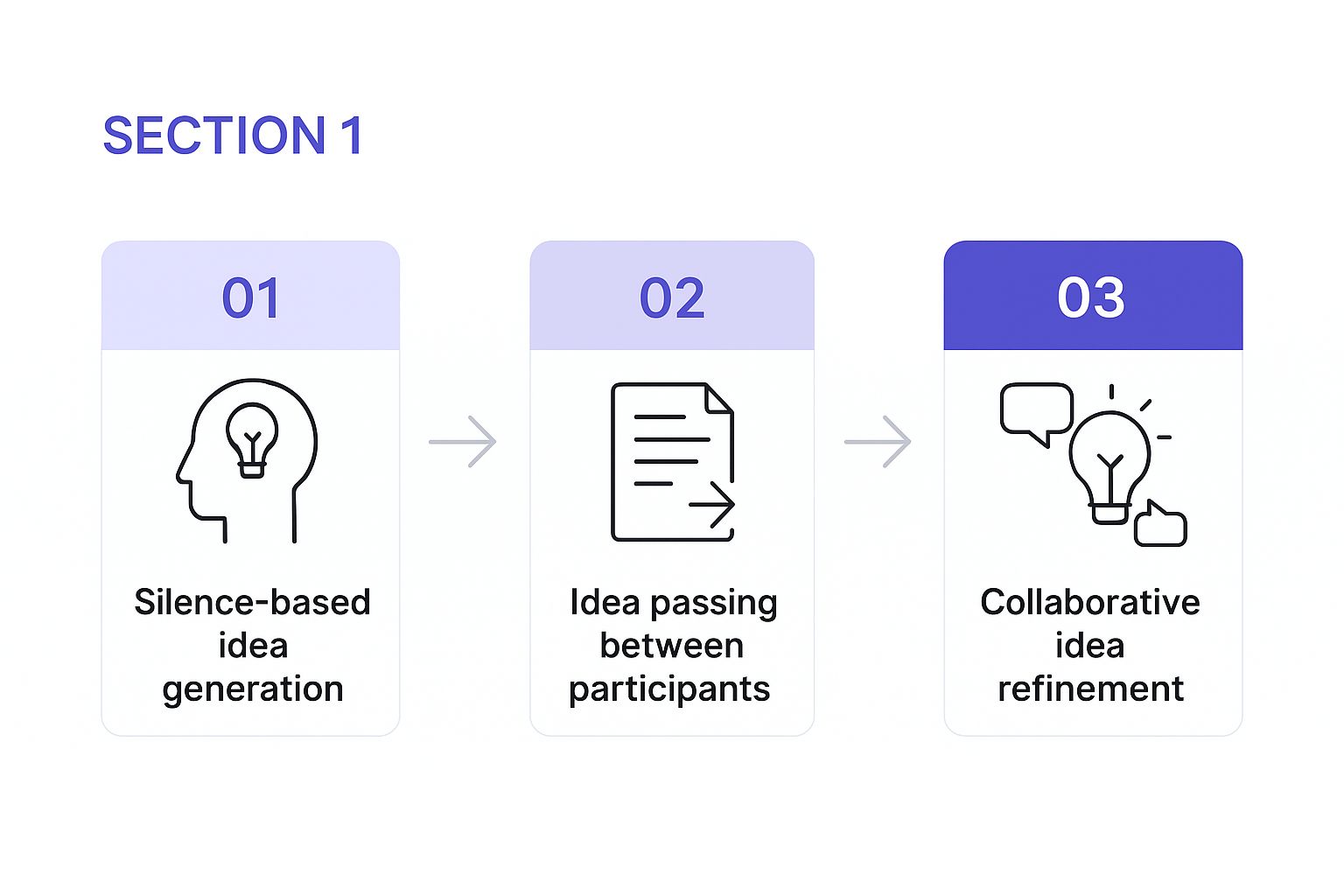So, what exactly is brainwriting? Think of it as a silent, collaborative way to generate ideas. Instead of a free-for-all discussion, team members write down their thoughts first and then pass them along for others to build on. It’s a powerful alternative to traditional brainstorming that makes sure every voice is heard, not just the loudest one.
So, What Is Brainwriting, Really?

Picture a typical brainstorming meeting. You know the scene—a few outgoing people tend to dominate the conversation, throwing out idea after idea. Meanwhile, others with potentially brilliant thoughts hang back, maybe because they’re more introverted or just can’t find a gap to speak. This common setup can quickly lead to groupthink, where the first few suggestions end up steering the entire session.
Brainwriting completely flips this dynamic on its head by changing one simple rule: instead of talking, you write.
Let’s use an analogy. Traditional brainstorming is like a chaotic race for the microphone, where only the fastest and loudest get a turn. Brainwriting, on the other hand, is more like a structured relay race. Each person runs their leg of the race (writes down their ideas) and then cleanly passes the baton (their written thoughts) to the next teammate, who gets inspired and takes off from there.
A Structured Path to Creativity
This simple switch from speaking to writing encourages deeper, more focused thinking. When you remove the pressure of speaking in front of a group and the distraction of constant chatter, people can truly concentrate on generating their best ideas. This structured approach isn’t new; it has proven to be an incredibly effective alternative to older methods.
For example, the well-known 6-3-5 brainwriting technique, developed way back in 1968 by Bernd Rohrbach, is a perfect illustration. This method can generate an incredible 108 ideas in just 30 minutes by ensuring everyone participates equally and silently. You can find more details on this specific structure over at 4strat.com.
The core idea is simple but incredibly effective: separate the act of creating ideas from the act of discussing them. This separation prevents ideas from being judged too early and allows a much wider, more diverse range of concepts to emerge before anyone starts evaluating them.
Why It Works So Well
Brainwriting’s magic lies in its ability to tear down the psychological walls that often stifle creativity. By making contributions anonymous and simultaneous, it dials down the social anxiety and fear of saying something “wrong.”
Here’s why it’s so effective:
- True Equal Opportunity: It gives introverts, junior team members, and quieter thinkers the same platform as everyone else to share their thoughts without being interrupted.
- More Ideas, Faster: Since everyone is writing at the same time, you generate a much higher volume of raw ideas in a fraction of the time.
- Richer, More Diverse Ideas: By stopping the group from latching onto the first decent idea, brainwriting encourages a broader and more innovative pool of solutions.
So, when you ask, “What is brainwriting?”—it’s a simple, elegant system for unlocking the collective intelligence of your entire team. It’s not just about getting more ideas; it’s about getting better, more varied ideas from everyone in the room.
Your Guide to the 6-3-5 Brainwriting Method
So, you get the basic idea of brainwriting. Now, let’s get into the nitty-gritty of one of the most popular and structured versions out there: the 6-3-5 brainwriting method.
The name itself tells you everything you need to know. It’s a simple formula: 6 participants, 3 ideas per round, for 5 minutes per round. This structure is beautifully simple and incredibly effective at getting a ton of ideas out fast.
Think of it as a focused, high-energy sprint for creativity. Instead of a free-for-all discussion that can easily go off the rails, you get a tight, 30-minute session that can produce a staggering 108 ideas. It’s a fantastic way to kickstart any project or problem-solving session by generating a massive pool of raw material to work with.
Preparing for Your Session
Before you dive in, a little bit of prep work can make all the difference. The success of a 6-3-5 session really comes down to having a crystal-clear focus and the right setup.
Here’s what you need to do first:
- Frame the Problem: Start with a sharp, well-defined problem statement. It needs to be specific enough to keep people on track but broad enough to invite creative thinking. For example, instead of a vague goal like “How can we sell more?”, try something more focused like, “What new features could we add to our app to attract first-time users?”
- Gather Your Team: Get a group of six people together. The key here is diversity. Try to pull in people from different roles, backgrounds, and departments. Their varied perspectives are what will make the idea pool so rich. If you have more than six people, just break them into smaller groups.
- Prepare the Worksheets: Each of the six participants needs a simple worksheet. This can be a physical piece of paper or a digital document with a grid ready to capture three ideas across six rounds.
Getting this prep work done means that once the timer starts, everyone can hit the ground running.
This simple infographic breaks down the core flow of any brainwriting session.

As you can see, the process moves from quiet, individual thought to a more collaborative building phase. That’s really the secret sauce.
Running the Six Rounds of Ideas
Okay, you’ve got your problem statement and your team is ready to go. It’s time for the main event. The process is clean, simple, and usually led by a facilitator.
Here’s how it unfolds, step by step:
- Round 1 (5 Minutes): The facilitator reads the problem statement out loud. Then, in complete silence, each of the six participants jots down three initial ideas on their worksheet.
- Round 2 (5 Minutes): When the five minutes are up, everyone passes their worksheet to the person on their right. Each person now silently reads the three ideas on the sheet they just received and adds three more ideas. These can be brand new thoughts or, more powerfully, ideas that build on what’s already there.
- Rounds 3-6 (5 Minutes Each): You just keep this going. Every five minutes, you pass the sheet to the right and add three more ideas inspired by what your colleagues have written.
By the end of the sixth round, every worksheet has made a full circle. Each sheet is now filled with 18 ideas. With six worksheets in play, your team has just generated 108 ideas in 30 minutes.
If someone gets stuck, that’s perfectly normal. Just remind them that the goal here is quantity and inspiration, not perfection. A single word or a quick doodle could be the spark that ignites a brilliant idea for the next person who sees it.
To see these principles in a real-world context, you can check out this creative problem-solving example for more insight. It’s this blend of structured process and creative freedom that makes brainwriting such a powerful tool.
The Hidden Psychology That Makes Brainwriting Effective

Have you ever walked out of a brainstorming session feeling like a few great ideas got lost in all the noise? It’s a common feeling, and it’s not because the people were uncreative—it’s because the process itself was flawed. Traditional brainstorming can accidentally set up psychological traps that stifle creativity.
Brainwriting works so well because it’s designed to sidestep these exact problems. Its quiet, structured approach gets right to the heart of why so many idea-generation meetings just don’t deliver.
The first major issue brainwriting tackles is something called production blocking. This is what happens when a brilliant idea pops into your head, but you have to wait for someone else to stop talking. By the time it’s your turn, you might have forgotten it, or the conversation has shifted, making your point feel out of place.
Dodging the Roadblocks of Group Dynamics
Another huge barrier is evaluation apprehension, which is just a fancy term for the fear of being judged. How many times have you held back a quirky or half-baked idea because you were worried about what your boss or coworkers might think? That fear makes us self-censor, and we end up sticking to safe, predictable suggestions.
Brainwriting elegantly solves both of these problems. Since everyone writes their ideas down at the same time and in silence, production blocking simply vanishes. There’s no waiting for your turn, so ideas get captured the moment they surface.
The anonymity of writing ideas down also lowers the pressure. It immediately eases that evaluation apprehension, creating a space that feels psychologically safe. People feel more comfortable sharing bolder, more innovative thoughts without the fear of instant criticism. By fostering this environment, brainwriting taps into more effective problem-solving techniques that prioritize getting ideas out first and judging them later.
In controlled studies, groups using brainwriting consistently produced more ideas—and ideas of higher quality—than groups using traditional verbal brainstorming. The structure helps diminish social pressures, empowering quieter members to contribute fully.
Tapping into Collective and Individual Strengths
By creating this structured silence, brainwriting cleverly harnesses two types of thinking: deep individual focus and shared group inspiration. You get time for uninterrupted thought, which is where many of the best initial concepts are born.
Then, as you start passing the notes around, you get that collaborative spark from seeing what others came up with. This cross-pollination happens without the chaotic and often competitive energy of a verbal free-for-all. It’s a system built to bring out the best of both individual creativity and group genius.
This improved productivity isn’t just a feeling; research has backed it up. Studies comparing brainwriting to other methods show that brainwriting groups don’t just generate more ideas, but their ideas are consistently rated as more novel and useful.
What Are the Real Benefits of Brainwriting?
Switching to brainwriting brings some serious, real-world results that go way beyond just getting a longer list of ideas. The true magic is in how it changes the very fabric of your team’s creative and problem-solving engine. It creates a space where everyone, no matter their personality or job title, can actually contribute on equal terms.
Think about your last team meeting. Chances are, you have brilliant people on your team—introverts, junior staff—who stay quiet, not because they have nothing to say, but because it’s hard to jump into a fast-moving discussion. Brainwriting gives them a voice. It hands them a pen and paper (or a keyboard) and a quiet moment to share their thoughts without being interrupted.
This simple change completely levels the playing field. It ensures that valuable, and often different, perspectives aren’t lost in the noise. The goal is to create a culture where you can truly unlock imagination and boost productivity by making sure every voice is heard.
Get More Done and Go Deeper
Brainwriting is also incredibly efficient. A single, structured session like the 6-3-5 method can churn out over 100 ideas in just 30 minutes. That’s a massive head start, giving your team a rich pool of concepts to work with instead of spending hours in a meeting that goes nowhere.
But this speed doesn’t sacrifice quality. In fact, it often improves it by systematically taking apart one of the biggest creativity killers: groupthink. You know the drill—a few people talk first, and suddenly everyone is just riffing on the same two ideas.
Brainwriting forces everyone to think on their own before any discussion begins. This guarantees you start with a diverse set of ideas. Concepts are then judged based on their own merit, not on who came up with them or who spoke the loudest.
This structured approach is a cornerstone of any solid creative workflow. If you want to see how this fits into the larger journey from idea to execution, our guide on the complete innovation steps and process breaks it all down.
So, what can you really expect?
- Genuine Inclusivity: It gives quieter team members and introverts a platform to share their best ideas, right alongside their more outspoken colleagues.
- A Flood of Ideas: The process is designed for parallel work, meaning you get a huge number of ideas in a surprisingly short amount of time.
- Better, Stronger Concepts: As people build on each other’s written thoughts, ideas naturally combine and evolve into more creative and well-rounded solutions.
- Bye-Bye, Groupthink: By separating idea generation from discussion, it stops dominant personalities from hijacking the session and allows for truly original thoughts to surface.
How to Adapt Brainwriting for Any Challenge

The best part about brainwriting is that it’s not a strict, one-size-fits-all process. Think of it more like a flexible recipe than a rigid formula. You can tweak its core ingredients—silent thinking and structured idea-sharing—to tackle just about any problem your team is up against.
This adaptability is where its real power lies. You don’t have to get locked into the classic 6-3-5 method every single time. With a few simple adjustments, you can shape the technique for anything from high-level strategic planning to nitty-gritty product design or even identifying potential risks. It’s a true Swiss Army knife for your team’s creative toolkit.
One of my favorite variations is the brainwriting premortem. Instead of asking, “How do we make this project a success?” you completely flip the script. You ask, “Imagine it’s a year from now and this project was a total disaster. What went wrong?” From there, everyone silently jots down all the reasons for the failure.
Mastering Different Brainwriting Styles
The premortem approach is a brilliant way to get ahead of problems before they ever happen. It’s been a game-changer in fields like healthcare and research, where catching a potential pitfall early can make all the difference. In fact, studies show a focused premortem can be done in as little as 10 minutes, giving you a quick, powerful alternative to drawn-out focus groups.
But the variations don’t stop there. Depending on your team and goals, you might try:
- Round Robin Brainwriting: This works great for smaller groups. Everyone writes down one idea on a card and passes it to the person next to them. That person then adds a related idea, and the passing continues until the cards are filled. It creates a beautiful chain reaction of creativity.
- Digital Brainwriting: For remote or hybrid teams, this is the way to go. You can use a shared document or a virtual whiteboard to keep the process moving. Everyone gets to work in parallel, just like they would in person, but from anywhere in the world.
The secret is to stop thinking of brainwriting as a single method and start seeing it as a concept. Once you grasp its psychological power—how it eases social anxiety and promotes deep thinking—you can invent your own versions tailored perfectly to your team’s needs.
Taking Brainwriting Remote
Moving brainwriting to a remote setting is surprisingly simple with the right tools, like Bulby. When you can’t physically pass a sheet of paper, digital platforms become your new best friend. To pull it off, you’ll want to lean on good remote collaboration tools to keep ideas flowing and organized.
Getting a digital session going is easy. Just set up a shared document or a virtual whiteboard space. Give each person their own area to write, and when it’s time to switch, they just scroll to the next person’s section to add their thoughts. If you want to hit the ground running, you can even use a pre-made brainstorming session template to get everything structured.
Whether you’re gathered in a conference room or collaborating across continents, the goal is always the same: create a quiet, structured space where brilliant ideas can emerge.
Common Brainwriting Questions Answered
Even after you get the hang of what brainwriting is, it’s totally normal for a few practical questions to pop up before your first real session. When you’re trying out any new method, you naturally start thinking through the “what ifs” and how you’ll handle them in the moment.
Let’s walk through some of the most common questions facilitators and team members have. The goal here is to give you clear, straightforward answers so you can step into your next brainwriting session feeling completely confident.
What If Team Members Are Slow Writers or Get Stuck?
This is a really common worry, but brainwriting is actually designed to prevent this very problem. The short, timed rounds create just enough urgency to get the creative juices flowing, rather than causing a block. It’s also important to remind your team that the first few ideas don’t have to be perfect, fully-formed concepts.
Here are a few tips to keep things moving:
- Encourage simple ideas. A single word, a short phrase, even a rough sketch is a perfect contribution. In the beginning, we’re aiming for quantity, not quality.
- Lean on built-in inspiration. The magic of brainwriting is that you’re constantly seeing what others have written. This cross-pollination is fantastic for jogging your mind when you feel a temporary block.
- Adjust the time. If your team is brand new to this, feel free to add a minute or two to the rounds. Bumping the time from five to six or seven minutes can ease everyone into the rhythm.
The key is creating a low-pressure environment. As long as everyone knows that any contribution is valuable, the constant flow of seeing new ideas is usually more than enough to keep the momentum going.
Can We Use Brainwriting With a Remote or Hybrid Team?
Absolutely. Brainwriting is a perfect fit for remote and distributed teams. In many ways, digital tools like Bulby can make the entire process even smoother and more organized. And you don’t need fancy software to pull it off.
You can easily run a session using a simple, shared Google Doc or Sheet. If you want a more visual and dynamic experience, digital whiteboard platforms are fantastic. Many of them even have ready-made brainwriting templates. You can check out some of the best brainstorming tools online to see what’s out there.
The digital process mirrors the physical one:
- Everyone writes silently in their own digital space.
- When the timer dings, they “pass” by moving to the next person’s section or document.
- They read the existing ideas and build on them with their own.
This setup keeps all the core benefits—silent ideation, equal contribution—no matter where your team is located.
How Do We Sort Through All the Ideas Afterward?
Generating a ton of ideas—sometimes over 100 in a single session—is a great problem to have. But this next step is critical. If you don’t have a plan for sorting through everything, all that creative energy can fizzle out.
The most important part of this phase is to make it a collaborative effort. After the silent writing is done, the discussion and prioritization should involve the whole team. This ensures continued buy-in and a shared sense of ownership over the outcomes.
First, get all the ideas up where everyone can see them, either on a physical wall or a shared digital board. Then, work together as a group to cluster similar ideas into themes. This process, often called affinity mapping, brings order to the chaos and makes the output much easier to understand.
Once your ideas are grouped, use a simple voting method like dot voting. Give each person a few virtual or physical dots to place on the ideas or themes they think are most promising. This is a quick, democratic way to see where the group’s energy is and gives you a clear starting point for a more focused discussion on the top contenders.
What Is the Best Group Size for a Brainwriting Session?
The classic 6-3-5 method is built for 6 participants, which is often considered the sweet spot. A group of this size gives you a great mix of perspectives while still being easy to manage.
But the technique is incredibly flexible. You definitely don’t need to cancel a session just because you don’t have exactly six people.
- For smaller groups (3-4 people): You can simply adjust the number of rounds or ideas per round. The core principle of silently generating and passing ideas works just as well.
- For larger groups (8 or more): The best way to handle this is to break everyone into smaller sub-groups of 4-6 people. Each sub-group can run its own brainwriting session at the same time.
This “divide and conquer” strategy keeps the process moving fast and ensures every single person can contribute effectively without the logistics getting complicated.
Ready to run brainwriting sessions that are perfectly structured for remote teams? Bulby guides your team step-by-step through research-backed exercises that eliminate groupthink and ensure every idea is captured. Transform your virtual collaboration and unlock your team’s full creative potential at https://www.bulby.com.

